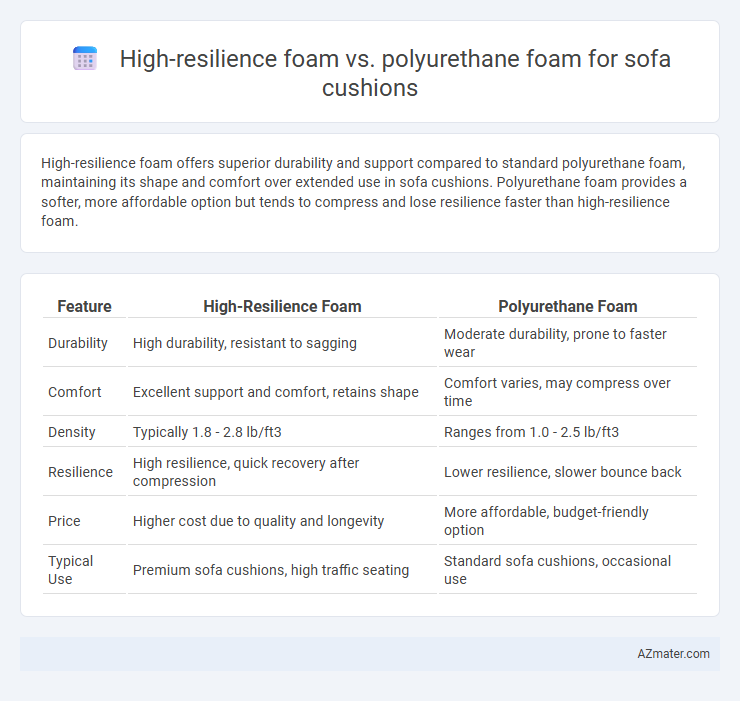High-resilience foam offers superior durability and support compared to standard polyurethane foam, maintaining its shape and comfort over extended use in sofa cushions. Polyurethane foam provides a softer, more affordable option but tends to compress and lose resilience faster than high-resilience foam.
Table of Comparison
| Feature | High-Resilience Foam | Polyurethane Foam |
|---|---|---|
| Durability | High durability, resistant to sagging | Moderate durability, prone to faster wear |
| Comfort | Excellent support and comfort, retains shape | Comfort varies, may compress over time |
| Density | Typically 1.8 - 2.8 lb/ft3 | Ranges from 1.0 - 2.5 lb/ft3 |
| Resilience | High resilience, quick recovery after compression | Lower resilience, slower bounce back |
| Price | Higher cost due to quality and longevity | More affordable, budget-friendly option |
| Typical Use | Premium sofa cushions, high traffic seating | Standard sofa cushions, occasional use |
Introduction to Sofa Cushion Foams
High-resilience (HR) foam and polyurethane foam serve as primary materials in sofa cushions, each offering distinct comfort and durability benefits. HR foam features an open-cell structure that enhances breathability and provides superior support and resilience, making it ideal for long-lasting seating comfort. Polyurethane foam, available in various densities and firmness levels, delivers cost-effective cushioning but generally wears out faster and offers less rebound compared to high-resilience foam.
What is High-Resilience Foam?
High-resilience foam is a type of polyurethane foam distinguished by its superior elasticity, durability, and support, making it ideal for sofa cushions designed for long-term comfort. Characterized by a higher density (typically 1.8 to 2.8 lbs per cubic foot) and an open-cell structure, high-resilience foam offers enhanced bounce-back and resistance to sagging compared to conventional polyurethane foam. These properties result in cushions that maintain shape and provide consistent support, contributing to extended sofa life and improved seating comfort.
What is Polyurethane Foam?
Polyurethane foam is a versatile, synthetic material widely used in sofa cushions for its durability and comfort. It offers varying densities and firmness levels, making it suitable for different seating preferences and support needs. Compared to high-resilience foam, traditional polyurethane foam may compress faster but remains cost-effective and readily available.
Key Differences Between High-Resilience and Polyurethane Foam
High-resilience foam offers superior durability and elasticity compared to traditional polyurethane foam, providing better support and comfort for sofa cushions over extended periods. Polyurethane foam tends to compress and lose shape faster due to its lower density and resilience, which impacts long-term seating quality. High-resilience foam's open-cell structure allows for enhanced airflow and breathability, while polyurethane foam typically has a denser composition that can trap heat.
Durability and Longevity Comparison
High-resilience foam offers superior durability compared to standard polyurethane foam due to its higher density and faster recovery rate, making it ideal for sofa cushions subjected to frequent use. Its enhanced cell structure resists sagging and maintains shape longer, contributing to extended longevity in furniture applications. Polyurethane foam, while cost-effective, tends to break down faster under regular pressure, leading to quicker deformation and reduced cushion lifespan.
Comfort and Support: Which Foam Performs Better?
High-resilience (HR) foam provides superior comfort and support for sofa cushions due to its higher density and elasticity, allowing it to retain shape and offer consistent firmness over time. Polyurethane foam, while more affordable, tends to compress faster, resulting in less durable support and eventual sagging. For long-lasting comfort and optimal spinal alignment, HR foam outperforms standard polyurethane foam in sofa cushioning applications.
Breathability and Temperature Regulation
High-resilience foam offers superior breathability compared to traditional polyurethane foam, allowing better air circulation within sofa cushions to prevent heat buildup. Its open-cell structure promotes enhanced temperature regulation, ensuring a cooler and more comfortable seating experience over extended periods. Polyurethane foam tends to retain heat due to its denser composition, making it less effective at maintaining airflow and dissipating body heat.
Cost Analysis: High-Resilience vs Polyurethane Foam
High-resilience (HR) foam typically costs more upfront than polyurethane (PU) foam due to its superior durability and support, making it a long-term investment for sofa cushions. Polyurethane foam offers a budget-friendly option with varying density and firmness levels but generally wears out faster, leading to more frequent replacements. Considering life cycle costs, HR foam provides better value through enhanced comfort retention and resilience, whereas PU foam appeals to cost-conscious buyers prioritizing lower initial expenditure.
Eco-Friendliness and Health Considerations
High-resilience foam offers superior durability and breathability compared to standard polyurethane foam, making it a more eco-friendly choice due to its longer lifespan and reduced need for replacement. This foam type typically uses less harmful chemicals and emits lower levels of volatile organic compounds (VOCs), supporting better indoor air quality and healthier living environments. Polyurethane foam, while more common and cost-effective, often contains higher concentrations of toxic additives and degrades faster, contributing to environmental waste and potential respiratory irritation.
Which Foam Is Best for Your Sofa Cushion?
High-resilience foam offers superior durability, better support, and greater responsiveness than polyurethane foam, making it ideal for sofa cushions that require long-lasting comfort and shape retention. Polyurethane foam is generally more affordable but tends to compress and lose its supportive qualities faster over time. For optimal comfort and durability in your sofa cushion, high-resilience foam is the best choice, especially for frequent use.

Infographic: High-resilience foam vs Polyurethane foam for Sofa cushion
 azmater.com
azmater.com